Introduction to Mosquitoes
Mosquitoes are small, flying insects belonging to the family Culicidae. Despite their delicate appearance, they are considered the world’s most dangerous insects due to their ability to transmit deadly diseases. Found on every continent except Antarctica, mosquitoes have a significant impact on both human health and global ecosystems.
Mosquitoes are a type of fly. They are part of the order Diptera, which includes all true flies characterized by having a single pair of wings. Mosquitoes share this trait but are distinguished by their slender bodies, long legs, and elongated mouthparts designed for piercing skin and siphoning fluids.
While mosquitoes are often seen solely as pests, mosquitoes play essential roles in various ecosystems. Here are some of the beneficial aspects:
- Pollination: Some mosquito species feed on nectar and contribute to the pollination of plants, especially in wetlands and marshes.
- Food Source: Mosquitoes serve as a vital food source for many animals, including birds, bats, fish, and amphibians. Their larvae are especially important in aquatic food chains.
- Nutrient Recycling: Mosquito larvae help break down organic matter in water bodies, aiding in nutrient cycling and supporting aquatic life.
Understanding mosquitoes is crucial not only because of the health risks they pose but also due to their ecological significance. By learning about their biology and role in the environment, we can develop more effective strategies for mosquito control that minimize negative impacts on ecosystems
Mosquito Biology and Life Cycle
Mosquitoes are intricate insects with a life cycle that allows them to adapt and thrive in various environments. Understanding their biology and life cycle is essential for effective mosquito control and prevention strategies.
Anatomy of a Mosquito
A mosquito’s body is divided into three main parts: the head, thorax, and abdomen. Each part plays a vital role in their survival and reproduction.
Head
- Eyes: Mosquitoes have two large compound eyes that provide a wide field of vision. These eyes detect movement and help locate hosts.
- Antennae: Sensitive organs that pick up chemical signals like carbon dioxide and body odors, guiding mosquitoes toward their prey.
- Proboscis: A long, needle-like mouthpart used by female mosquitoes to pierce the skin and feed on blood. Male mosquitoes have a beak but do not bite humans or animals.
Thorax
- Wings: Mosquitoes possess one pair of wings attached to the thorax, enabling flight. They can fly at speeds of 1 to 1.5 miles per hour.
- Legs: Six long, slender legs allow them to land on various surfaces, including vertical walls and ceilings.
- Flight Muscles: Powerful muscles within the thorax facilitate wing movement and flight agility.
Abdomen
- Digestive System: Houses the stomach and intestines, where digestion and nutrient absorption occur.
- Reproductive Organs: In females, the abdomen expands after a blood meal to accommodate developing eggs.
Mosquito Life Cycle
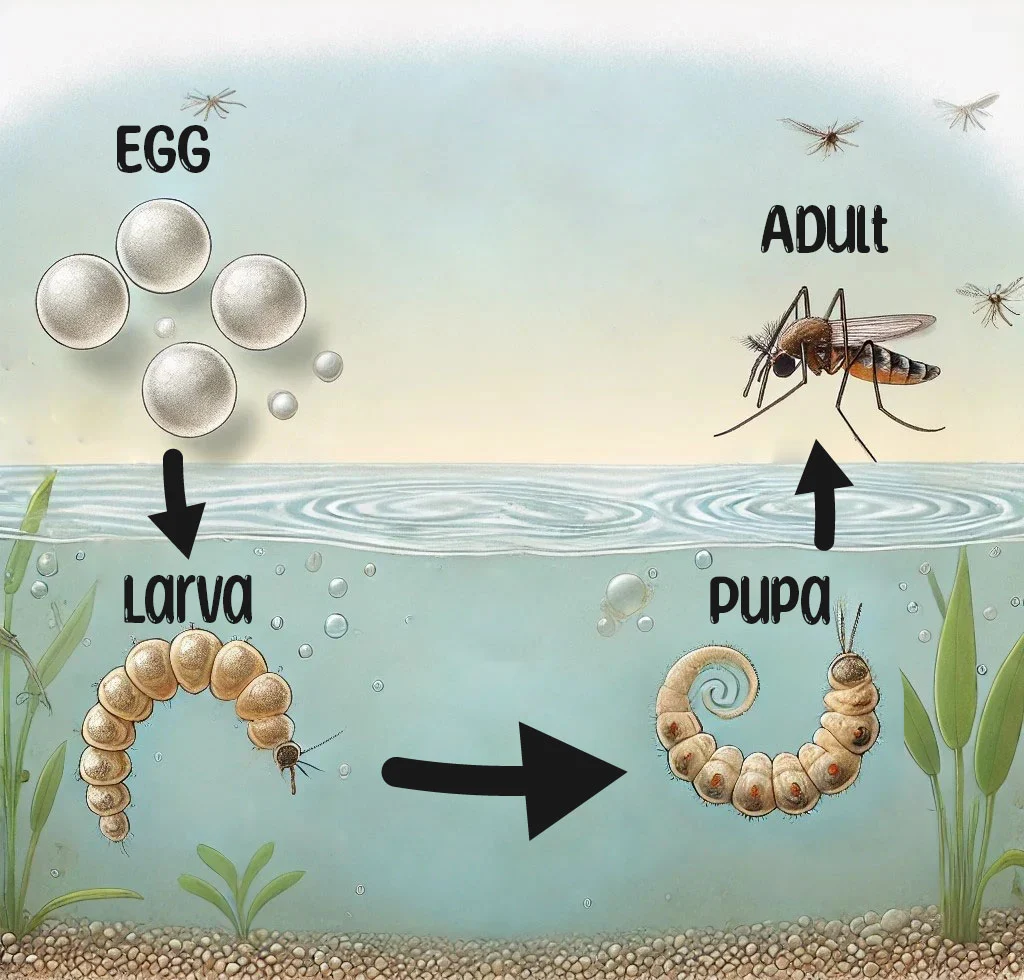
The mosquito life cycle consists of four distinct stages: egg, larva, pupa, and adult. This complete metamorphosis can take as little as eight days or up to a month, depending on the species and environmental conditions.
Egg Stage
Female mosquitoes lay eggs in or near standing water, which is crucial for their development.
- Egg Laying Habits: Some species, like Aedes aegypti, lay eggs on damp surfaces just above the waterline, while others deposit them directly on the water’s surface.
- Quantity of Eggs: A single female can lay anywhere from 100 to 300 eggs at a time.
- Incubation Period: Eggs typically hatch within 24 to 48 hours, but some can survive dry conditions for months until they are submerged in water.
Larva Stage
After hatching, mosquito larvae, known as “wrigglers,” live in water and undergo growth and development.
- Appearance: Larvae have elongated, segmented bodies with a distinct head equipped with mouth brushes for feeding.
- Diet: They feed on organic matter, microorganisms, and algae present in the water, playing a role in the aquatic food chain.
- Behavior: Larvae come to the water’s surface to breathe through a siphon tube located at their posterior end.
- Duration: This stage lasts between 5 to 14 days, during which larvae molt four times, growing larger each time.
Pupa Stage
The pupa, or “tumbler,” stage is when the mosquito transforms into an adult.
- Characteristics: Pupae are comma-shaped and more active than larvae, tumbling in the water when disturbed.
- Non-feeding: Pupae do not eat; instead, they rely on energy reserves accumulated during the larval stage.
- Duration: This stage typically lasts 1 to 4 days, depending on temperature and species.
Adult Mosquito
Emerging from the pupal case, the adult mosquito rests on the water’s surface until its body hardens and its wings dry.
- Maturation: Within a few days, adults become sexually mature and ready to reproduce.
- Feeding Habits:
- Males: Feed exclusively on nectar and plant juices, playing a role in pollination.
- Females: They require a blood meal to obtain proteins necessary for egg development but also feed on nectar for energy.
- Lifespan:
- Male Mosquitoes: Live for about 5 to 7 days.
- Female Mosquitoes: Can live from two weeks to a month, sometimes longer under ideal conditions.
Understanding the mosquito life cycle is crucial because it highlights the stages where control efforts can be most effective. For instance, eliminating standing water can disrupt the egg and larval stages, significantly reducing mosquito populations.
Common Mosquito Species
There are over 3,500 species of mosquitoes worldwide, but only a few are significant in terms of their impact on human health. Understanding the characteristics of common mosquito species can help identify risks and implement effective control measures.
Anopheles Mosquito
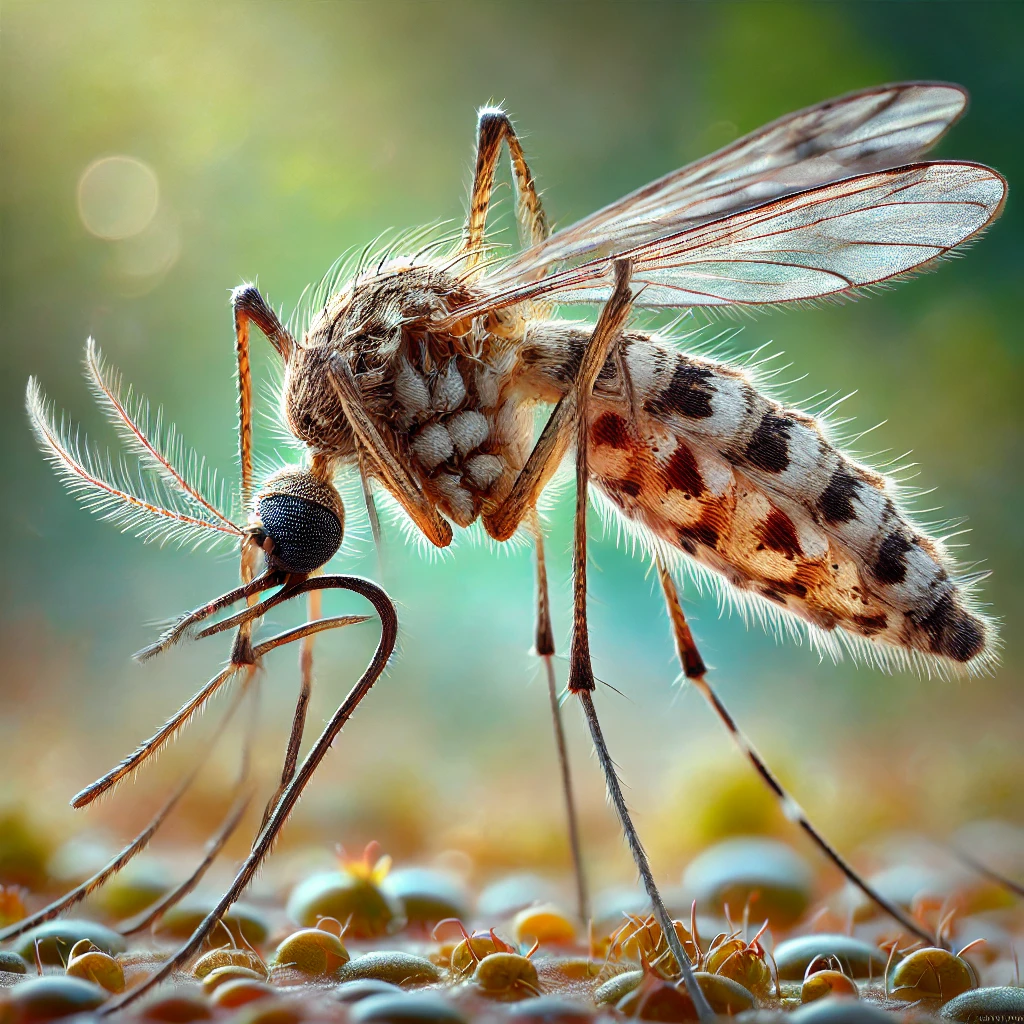
Identification and Characteristics
- Appearance: Anopheles mosquitoes are generally dark brown with pale spots on their wings. They can be identified by their resting position—at a 45-degree angle with their abdomen sticking up.
- Behavior: Active during dawn and dusk (crepuscular). Only the female Anopheles mosquito bites humans.
Regions Where They Are Commonly Found
- Global Distribution: Predominantly in Africa, Asia, Central and South America, and some parts of Europe.
- Habitat: Prefer clean, unpolluted water sources like marshes, swamps, and rice fields for breeding.
Diseases Transmitted
- Malaria: The primary vector for malaria, causing over 200 million cases annually.
- Lymphatic Filariasis: Can transmit parasites leading to this debilitating disease.
Aedes Mosquito
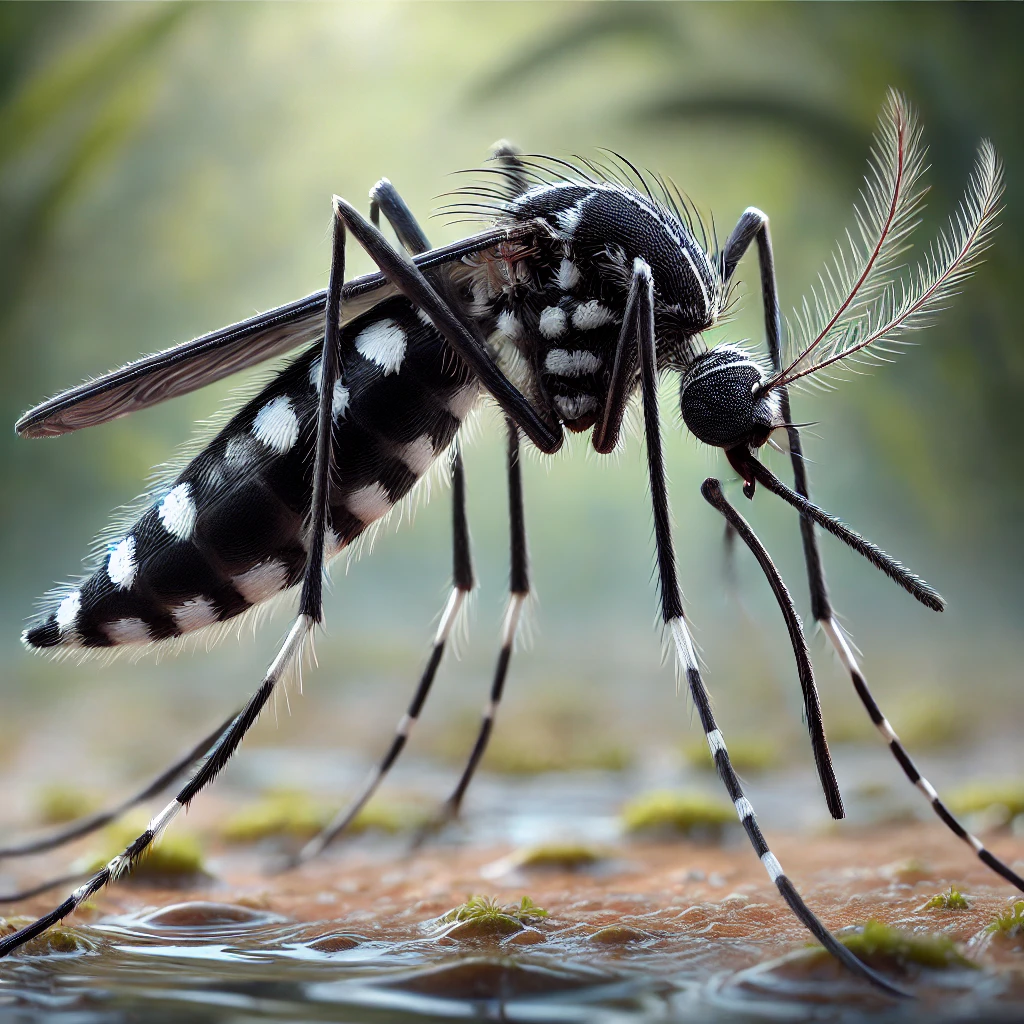
Notable Species
- Aedes aegypti: Known as the yellow fever mosquito, identifiable by white markings on the legs and a lyre-shaped pattern on the thorax.
- Aedes albopictus: Also called the Asian tiger mosquito, it is recognized by a single white stripe down the center of its back.
Diseases Transmitted
- Dengue Fever: Responsible for millions of infections each year.
- Zika Virus: Linked to congenital disabilities like microcephaly when contracted during pregnancy.
- Chikungunya: Causes severe joint pain and fever.
- Yellow Fever: Historically, there have been significant outbreaks in Africa and South America.
Behavior and Habitat
- Daytime Biters: Unlike many mosquitoes, Aedes species are active during the day, especially in the early morning and late afternoon.
- Breeding Sites: Prefer artificial containers with standing water—flower pots, discarded tires, and clogged gutters.
- Human Preference: Have a strong preference for biting humans over animals.
Culex Mosquito
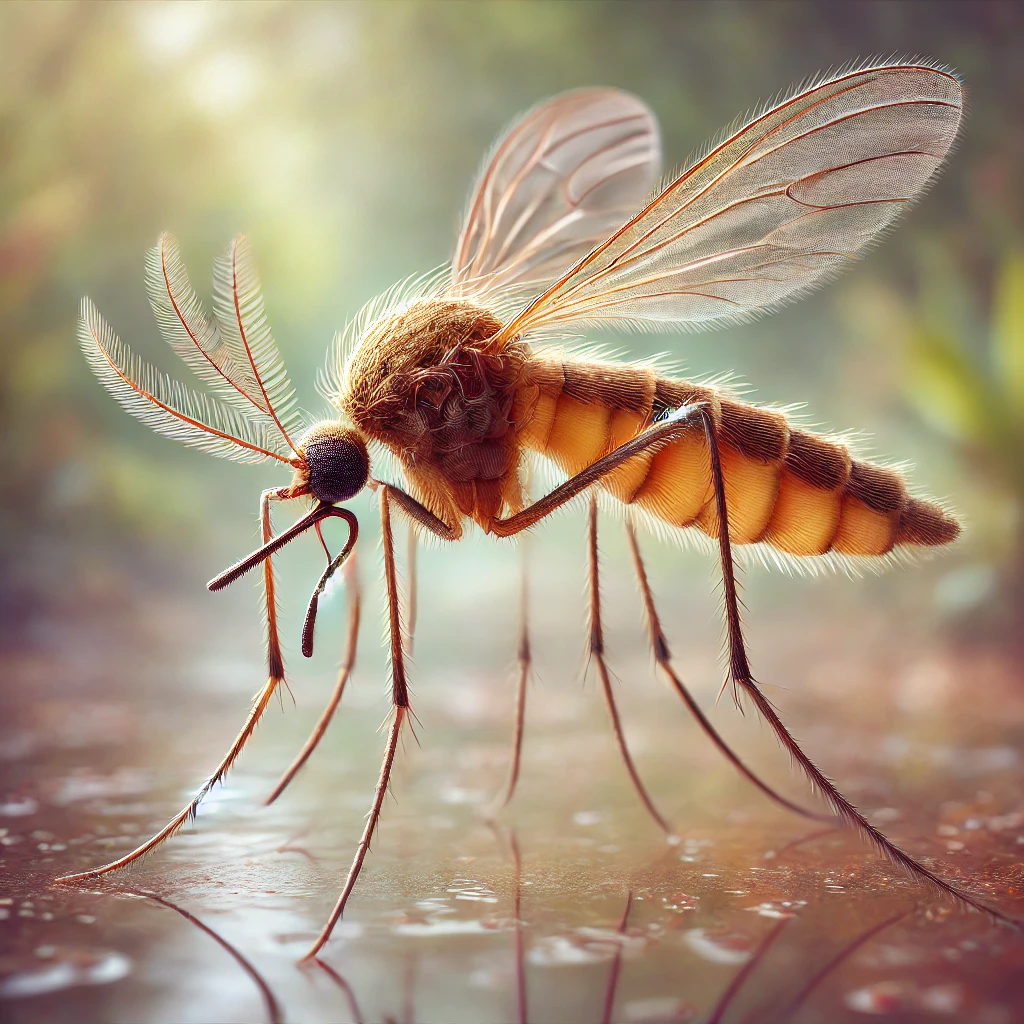
Identification and Characteristics
- Appearance: Generally brown with no distinctive markings. They hold their bodies parallel to surfaces when resting.
- Behavior: Primarily nocturnal, feeding from dusk to dawn.
Regions Where They Are Commonly Found
- Global Presence: Found in temperate and tropical regions worldwide.
- Habitat: Breed in stagnant water with high organic content—ditches, septic tanks, and polluted ponds.
Diseases Transmitted
- West Nile Virus: Leading cause of mosquito-borne disease in the continental United States.
- St. Louis Encephalitis: Causes inflammation of the brain.
- Lymphatic Filariasis: In some regions, it can transmit filarial worms.
Mansonia Mosquito
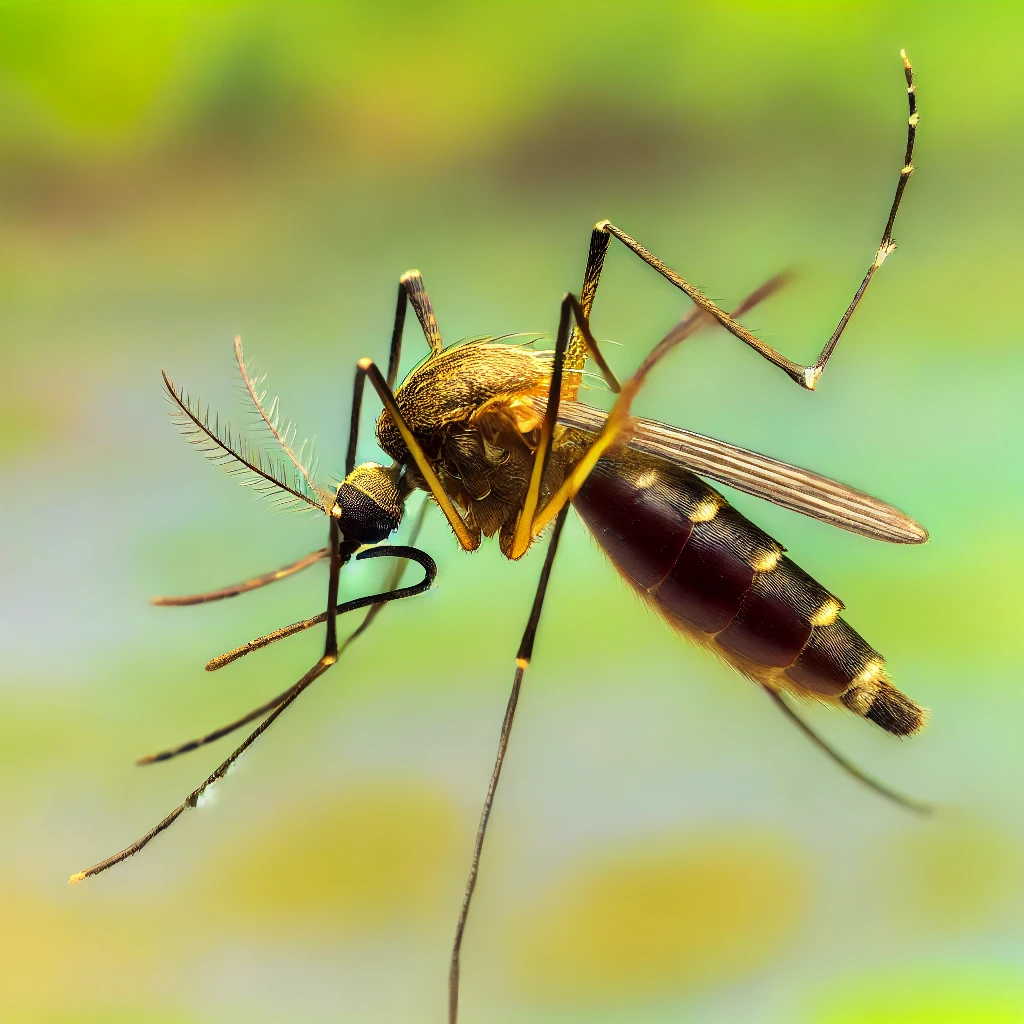
Identification and Characteristics
- Appearance: Medium-sized with brownish scales and speckled wings.
- Unique Traits: Larvae and pupae attach to aquatic plants to breathe.
Regions Where They Are Commonly Found
- Geographical Distribution: Mostly in tropical Asia, Africa, and Australia.
- Habitat: Swamps and marshes with abundant aquatic vegetation.
Diseases Transmitted
- Brugian Filariasis: A form of lymphatic filariasis prevalent in certain tropical regions.
Psorophora Mosquito
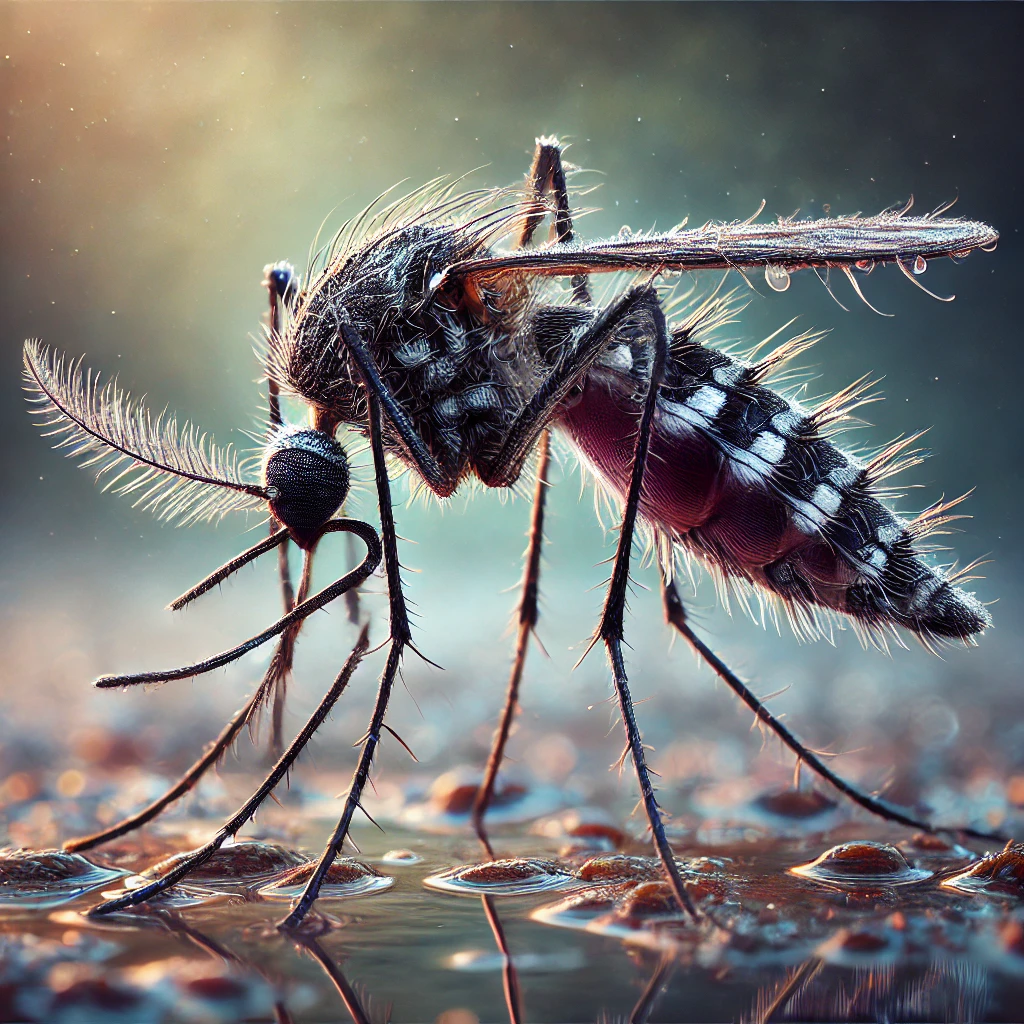
Identification and Characteristics
- Appearance: Larger than most mosquitoes, with robust bodies and often dark scales.
- Behavior: Known for their aggressive biting during the day.
Regions Where They Are Commonly Found
- Location: Primarily in the Americas, especially in the southern United States.
- Habitat: Breeds in temporary floodwaters, such as rain pools and flood plains.
Diseases Transmitted
- Diseases: While not primary vectors, they can transmit viruses like Venezuelan equine encephalitis.
Mosquito Habitats and Distribution
Mosquitoes are among the most adaptable insects on Earth, occupying a vast array of habitats across the globe. Understanding where mosquitoes live and breed is crucial for effective mosquito control and prevention of mosquito-borne diseases.
Global Distribution of Mosquitoes
- Worldwide Presence: Mosquitoes are found on every continent except Antarctica. Their ability to thrive in diverse environments makes them one of the most widespread insects.
- Climate Preferences: While they prefer warm and humid climates, some species have adapted to colder regions, demonstrating remarkable resilience.
Where Do Mosquitoes Live?
Mosquitoes inhabit areas that provide suitable conditions for their survival and reproduction.
- Standing Water: Female mosquitoes lay their eggs in or near stagnant water. Includes ponds, marshes, swamps, and even small containers like flower pots and discarded tires.
- Urban Areas: In cities, mosquitoes breed in gutters, sewers, and any place where water can accumulate. Human-made structures often create ideal mosquito habitats.
- Forests and Wetlands: Natural environments like rainforests, mangroves, and wetlands offer abundant resources and breeding sites.
Mosquito Breeding Grounds
Identifying and eliminating mosquito breeding grounds is essential in controlling their populations.
- Common Breeding Sites:
- Natural Water Bodies: Lakes, ponds, slow-moving streams, and marshes.
- Artificial Containers: Buckets, cans, tires, birdbaths, and clogged gutters.
- Temporary Pools: Rain-filled ditches, puddles, and floodplains.
- Egg-Laying Habits:
- Anopheles Mosquitoes: Prefer clean, unpolluted water.
- Aedes Mosquitoes: Often lay eggs in artificial containers close to human dwellings.
- Culex Mosquitoes: Thrive in water with high organic content, like septic tanks and cesspools.
Seasonal Patterns and Activity
Seasonal changes and environmental conditions highly influence mosquito activity.
- Warm Seasons: Mosquito populations peak during spring and summer due to favorable temperatures and increased rainfall.
- Rainy Seasons: Heavy rains create more breeding sites, leading to a surge in mosquito numbers.
- Temperature Thresholds:
- Optimal Temperatures: Mosquitoes are most active between 50°F (10°C) and 95°F (35°C).
- Cold Weather: In colder climates, mosquitoes enter a dormant state called diapause to survive winter months.
Impact of Climate Change on Mosquito Distribution
Climate change is expanding mosquito habitats and altering their distribution patterns.
- Rising Temperatures: Warmer global temperatures enable mosquitoes to inhabit regions previously too cold for survival.
- Expanded Ranges: Diseases like dengue fever and Zika virus are emerging in new areas as mosquitoes migrate.
- Increased Breeding Seasons: Longer warm periods extend breeding seasons, increasing mosquito populations.
Urban vs. Rural Habitats
Mosquito habitats differ between urban and rural settings, each presenting unique challenges.
- Urban Environments:
- Breeding Sites: Construction sites, clogged drainage systems, and water storage facilities.
- Human Interaction: Higher population density increases the likelihood of mosquito-human contact.
- Rural Areas:
- Natural Habitats: Rivers, irrigated fields, and livestock watering holes.
- Vector Control: Limited resources may hinder effective mosquito control measures.
Adaptability of Mosquitoes
Mosquitoes have evolved to survive in a variety of harsh and changing conditions.
- High Altitudes: Some species can live at elevations above 8,000 feet (2,400 meters).
- Saline Environments: Certain mosquitoes breed in salt marshes and brackish waters.
- Desert Regions: Species like Anopheles sergentii have adapted to arid environments by breeding in oases.
Human Influence on Mosquito Habitats
Human activities significantly impact mosquito distribution.
- Urbanization: Expansion of cities creates new breeding sites through poor waste management and water storage practices.
- Deforestation: Alters ecosystems, sometimes increasing mosquito habitats by creating open, sunlit pools.
- Global Travel and Trade: Can introduce non-native mosquito species to new regions, affecting local ecosystems.
Preventing Mosquito Habitats
Reducing mosquito populations starts with eliminating their breeding grounds.
- Eliminate Standing Water:
- Regular Maintenance: Empty and clean containers that collect water, such as buckets, planters, and pet dishes.
- Proper Waste Disposal: Remove discarded tires, cans, and other debris that can hold water.
- Environmental Management:
- Drainage Systems: Ensure proper drainage in yards and public spaces to prevent water accumulation.
- Wetland Restoration: Manage wetlands to balance ecological health with mosquito control.
Community Efforts in Habitat Control
Community involvement is vital in reducing mosquito habitats.
- Public Education: Inform residents about the importance of eliminating standing water.
- Community Clean-Up Programs: Organize events to remove trash and potential breeding sites.
- Collaboration with Authorities: Work with local health departments for large-scale mosquito control initiatives.
Mosquito Behavior and Diet
Understanding mosquito behavior and diet is crucial for developing effective strategies to prevent bites and control mosquito populations. Mosquitoes exhibit a range of behaviors that enable them to locate hosts, feed, reproduce, and survive in various environments.
Feeding Habits
Why Do Mosquitoes Bite?
Only female mosquitoes bite humans and animals. They require a blood meal to obtain the proteins necessary for egg development. Male mosquitoes do not bite; instead, they feed exclusively on plant nectar.
- Blood Feeding: Females use their long proboscis to pierce the skin and draw blood.
- Protein Requirement: The proteins in blood help develop and lay eggs.
What Do Mosquitoes Eat Besides Blood?
Both male and female mosquitoes consume nectar and plant juices as their primary energy source.
- Nectar Feeding: Provides carbohydrates for energy needed in flight and daily activities.
- Role in Pollination: While feeding on nectar, mosquitoes inadvertently transfer pollen, aiding in plant reproduction.
Host-Seeking Behavior
Mosquitoes have developed sophisticated methods to locate their hosts.
Sensory Cues Used by Mosquitoes
- Carbon Dioxide (CO₂): Mosquitoes are attracted to the CO₂ exhaled by humans and animals.
- Body Heat: Warmth indicates the presence of a living host.
- Body Odor: Compounds like lactic acid, ammonia, and fatty acids emitted through sweat attract mosquitoes.
- Visual Cues: Movement and contrasting colors can draw mosquitoes toward potential hosts.
Why Are Some People More Attractive to Mosquitoes?
Certain factors make some individuals more appealing to mosquitoes:
- Blood Type: Studies suggest people with type O blood may attract more mosquitoes.
- Metabolic Rate: Higher metabolism leads to increased CO₂ output.
- Skin Microbiota: The bacteria on one’s skin can produce odors that are more attractive to mosquitoes.
- Pregnancy: Pregnant women exhale more CO₂ and have higher body temperatures.
Activity Patterns
When Are Mosquitoes Most Active?
Mosquito activity varies by species:
- Nocturnal Species: Culex mosquitoes are active in the evening and night.
- Diurnal Species: Aedes mosquitoes are active during the day, especially in the early morning and late afternoon.
- Crepuscular Species: Some mosquitoes are most active at dawn and dusk.
Flight Behavior
How Far Do Mosquitoes Fly?
- Flight Range: Most mosquitoes stay within 1-3 miles of their breeding site.
- Flight Speed: They fly at speeds of 1 to 1.5 miles per hour.
- Flight Height: Typically fly close to the ground, within 25 feet.
Flight Patterns
- Wind Influence: Mosquitoes avoid strong winds; calm weather increases mosquito activity.
- Attracted to Light: Some species are drawn to artificial lights at night.
Resting Behavior
Mosquitoes rest when they are not active or feeding.
- Indoor Resting: In dark, humid places like closets, under sinks, or behind curtains.
- Outdoor Resting: In shaded areas such as vegetation, under leaves, or in dense shrubbery.
Reproductive Behavior
Mating Practices
- Swarming: Male mosquitoes form swarms, usually at dusk, to attract females.
- Lifespan: Males typically live for about a week, while females can live up to a month.
Egg Development and Laying
- Blood Meal Requirement: Females need a blood meal before laying eggs.
- Egg-Laying Sites: Prefer standing water, as discussed in the Mosquito Habitats and Distribution section.
- Number of Eggs: Females can lay anywhere from 100 to 300 eggs at a time.
Survival Strategies
Overwintering
- Diapause: In colder climates, some mosquitoes enter a dormant state to survive winter.
- Egg Resilience: Eggs of certain species can withstand freezing temperatures and hatch when conditions improve.
Avoidance of Predators
- Natural Predators: Include birds, bats, fish, and other insects.
- Behavioral Adaptations: Mosquitoes may adjust their activity patterns to avoid times when predators are most active.
Impact on Disease Transmission
Mosquito behavior directly influences their ability to transmit diseases.
- Feeding Frequency: Frequent biting increases the chance of disease spread.
- Host Preference: Species that prefer human blood are more significant vectors for human diseases.
- Biting Habits: Day-biting mosquitoes, like Aedes aegypti, pose challenges for control because they are active when people are outdoors.
Interaction with the Environment
Response to Environmental Conditions
- Humidity: High humidity levels increase mosquito activity and longevity.
- Temperature: Optimal temperatures for mosquito activity range from 70°F to 80°F (21°C to 27°C).
- Rainfall: Creates breeding sites by filling natural and artificial containers with water.
Diseases Transmitted by Mosquitoes
Mosquitoes are notorious vectors of some of the world’s most dangerous diseases, impacting millions annually. Understanding these diseases is crucial for prevention and control.
Malaria
Malaria is caused by Plasmodium parasites transmitted through the bites of infected Anopheles mosquitoes. Symptoms include high fever, chills, and flu-like illness. Without prompt treatment, malaria can be fatal. According to the World Health Organization, there were approximately 229 million cases worldwide in 2019.
Dengue Fever
Dengue fever is spread primarily by the Aedes mosquitoes, notably Aedes aegypti. Symptoms range from mild fever to severe joint and muscle pain, earning it the nickname “breakbone fever.” Severe cases can lead to dengue hemorrhagic fever, which can be life-threatening. The Centers for Disease Control and Prevention reports dengue is endemic in over 100 countries.
Zika Virus
The Zika virus gained global attention due to its association with congenital disabilities like microcephaly. Transmitted by Aedes mosquitoes, Zika infection during pregnancy can result in serious fetal brain defects. Symptoms are generally mild, including fever, rash, and joint pain. Prevention focuses on mosquito control and protecting pregnant women from bites.
West Nile Virus
Culex mosquitoes carry West Nile virus and affect humans and animals. Most infected people show no symptoms, but some develop severe neurological illnesses like encephalitis or meningitis. There is no specific treatment, so prevention through mosquito bite avoidance is essential.
Yellow Fever
Yellow fever is a viral disease transmitted by Aedes mosquitoes. It causes symptoms like high fever, jaundice (yellowing of the skin and eyes), and bleeding. Vaccination is the most effective prevention method. Outbreaks are most common in tropical areas of Africa and South America.
Chikungunya
Chikungunya is spread by Aedes mosquitoes and is characterized by sudden onset of fever and severe joint pain. While rarely fatal, the joint pain can be debilitating and may last for months.
Lymphatic Filariasis
Also known as elephantiasis, this disease is caused by parasitic worms transmitted by mosquitoes. It leads to severe swelling in the limbs and genitals. The World Health Organization aims to eliminate it through mass drug administration and mosquito control.
Preventing Mosquito Bites
Protecting yourself from mosquito bites is essential to reduce the risk of mosquito-borne diseases. Here are effective strategies for preventing mosquito bites:
Personal Protection Methods
Use Mosquito Repellents
- Apply Insect Repellent: Use EPA-registered repellents containing DEET, picaridin, IR3535, or oil of lemon eucalyptus.
- Follow Instructions: Apply to exposed skin and clothing as directed on the product label.
- Reapply as Needed: Reapply according to the instructions, especially after swimming or sweating.
- Natural Alternatives: While natural repellents like citronella are available, they may offer shorter protection periods.
Wear Protective Clothing
- Cover Up: Wear long-sleeved shirts, long pants, and socks to minimize skin exposure.
- Light-Colored Clothing: Mosquitoes are less attracted to light-colored fabrics.
- Treat Clothing: Consider permethrin-treated clothing and gear for added protection.
Use Mosquito Nets
- Bed Nets: Sleep under insecticide-treated bed nets, especially in areas with high malaria risk.
- Protect Infants: Use nets over strollers and carriers when outdoors.
- Ensure Proper Installation: Make sure nets are free of holes and tucked under mattresses.
Home and Yard Protection
Eliminate Standing Water
- Remove Breeding Sites: Empty and scrub items that hold water, such as buckets, planters, toys, pools, birdbaths, and trash containers.
- Weekly Routine: Make it a habit to check your property weekly for standing water.
- Maintain Gutters: Clean clogged gutters to prevent water accumulation.
Install Screens and Barriers
- Window and Door Screens: Ensure windows and doors have screens without holes to keep mosquitoes outside.
- Seal Openings: Repair gaps around windows and doors where mosquitoes could enter.
Use Fans
- Outdoor Fans: Mosquitoes are weak fliers; fans can help deter them when spending time outdoors.
- Indoor Fans: Improve air circulation inside your home to reduce mosquito activity.
Educate Others
- Share Information: Spread awareness about mosquito prevention strategies.
- Travel Precautions: When visiting areas with high mosquito prevalence, take extra preventive measures.
Mosquito Control Methods
Effective mosquito control requires a combination of strategies targeting different stages of the mosquito life cycle. Implementing these methods can significantly reduce mosquito populations and minimize the risk of disease transmission.
Chemical Control
Insecticides and Larvicides
- Larvicides: Products like Bacillus thuringiensis israelensis (Bti) target mosquito larvae in standing water, preventing them from maturing into adults.
- Adulticides: Insecticides are used to kill adult mosquitoes. These can be applied through sprays or foggers.
- Usage Guidelines: Always follow label instructions and safety precautions when applying chemical treatments.
Biological Control
Natural Predators
- Fish: Introducing mosquito-eating fish like gambusia (mosquito fish) into ponds and water gardens can help reduce larvae.
- Birds and Bats: Encouraging habitats for insectivorous birds and bats can naturally decrease mosquito populations.
- Dragonflies: Known as “mosquito hawks,” dragonflies consume large numbers of mosquitoes and larvae.
Bacterial Agents
- Bti and Bs: Bacillus sphaericus (Bs) is another bacterium that is effective against mosquito larvae.
- Application: These are environmentally friendly options that specifically target mosquitoes without harming other wildlife.
Environmental Management
Eliminate Breeding Sites
- Drain Standing Water: Regularly remove water from containers, gutters, and other areas where mosquitoes breed.
- Modify Landscapes: Fill in low-lying areas where water collects and ensure proper drainage.
- Maintain Pools and Ponds: Keep swimming pools chlorinated and circulating; use aeration in ponds to disrupt larvae.
Vegetation Management
- Trim Foliage: Reduce dense vegetation where adult mosquitoes rest during the day.
- Remove Excess Plants: Aquatic plants can provide breeding grounds; manage them to prevent mosquito proliferation.
Mechanical Control
Barriers and Traps
- Mosquito Nets: Use nets around beds and outdoor areas to prevent bites.
- Window and Door Screens: Install fine mesh screens to keep mosquitoes out of homes.
- Mosquito Traps: Devices that attract and capture mosquitoes using light, CO₂, or heat.
Genetic Control
Sterile Insect Technique
- Sterilized Males: Release of sterilized male mosquitoes to mate with females, leading to non-viable eggs and population decline.
- Advantages: Target-specific and environmentally friendly.
Genetically Modified Mosquitoes
- Gene Editing: Mosquitoes modified to reduce lifespan or prevent disease transmission.
- Field Trials: Ongoing research is evaluating the effectiveness and safety of this method.
The Impact of Mosquitoes on Society
Mosquitoes significantly affect society on multiple levels, from public health crises to economic burdens and environmental concerns.
Public Health Burden
Mosquito-borne diseases like malaria, dengue fever, Zika virus, and West Nile virus cause millions of illnesses and deaths annually. According to the World Health Organization, more than half of the world’s population is at risk of these diseases. This immense health burden strains healthcare systems, especially in developing countries with limited resources.
Economic Consequences
The economic impact is substantial due to healthcare costs and lost productivity. Key economic effects include:
- Medical Expenses: Costs for treatment, hospitalization, and ongoing care for those affected.
- Prevention and Control Costs: Investments in mosquito control programs, research, and public health campaigns.
- Productivity Loss: Sick individuals are unable to work, affecting families and national economies. For instance, malaria is estimated to cost Africa over $12 billion annually in lost GDP.
Social and Environmental Effects
Mosquitoes impact the quality of life and can hinder social activities:
- Reduced Outdoor Activities: Fear of bites and disease transmission limits time spent outdoors.
- Educational Disruptions: Illness can lead to absenteeism in schools, affecting education.
- Environmental Concerns: Extensive use of insecticides may harm non-target species and contribute to ecological imbalance.
Influence of Climate Change
Climate change expands mosquito habitats by creating warmer temperatures and increased rainfall in new regions. This expansion leads to the spread of mosquito-borne diseases into previously unaffected areas, posing new challenges for global health.
Urbanization and Globalization
- Urban Growth: Rapid urbanization without proper infrastructure can create ideal breeding grounds due to poor sanitation and standing water.
- Global Travel and Trade: Increases the risk of introducing invasive mosquito species and diseases to new locations, necessitating international cooperation in surveillance and control efforts.
Conclusion
Key Takeaways About Mosquitoes
Mosquitoes are more than a mere annoyance—they are significant carriers of diseases that impact global health. Understanding their biology and behavior is essential in combating the risks they pose. Key points include:
- Global Impact: Mosquitoes transmit diseases like malaria, dengue fever, Zika virus, and West Nile virus, affecting millions worldwide.
- Lifecycle and Habitats: They breed in standing water and thrive in warm, humid environments. Eliminating breeding sites can significantly reduce populations.
- Behavior: Only female mosquitoes bite humans to obtain blood for egg development. They are attracted to carbon dioxide, body heat, and certain body odors.
- Prevention: Personal protection measures and community efforts are vital in preventing mosquito bites and controlling their spread.
Taking Action
Encouraging Proactive Measures
- Personal Protection: Use EPA-approved insect repellents, wear long-sleeved clothing, and install window and door screens to keep mosquitoes out.
- Eliminate Breeding Sites: Regularly remove standing water from items like buckets, tires, and plant saucers around your home.
- Stay Informed: Keep updated on local mosquito activity and follow public health advisories.
Community Involvement in Mosquito Control
- Participate in Clean-Up Drives: Join community efforts to remove trash and potential breeding sites in public areas.
- Support Local Programs: Advocate for and support municipal mosquito control initiatives and funding.
- Educate Others: Share information about mosquito prevention with neighbors and community groups.
Additional Resources
For more information and assistance, consult the following organizations:
- World Health Organization (WHO)
- Website: www.who.int
- Offers global guidance on mosquito-borne diseases and prevention strategies.
- Centers for Disease Control and Prevention (CDC)
- Website: www.cdc.gov
- Provides comprehensive resources on prevention, symptoms, and treatment of mosquito-borne illnesses.
FAQs About Mosquitoes
Why Do Mosquito Bites Itch?When a mosquito bites, it injects saliva into your skin to prevent your blood from clotting. Your immune system reacts to the proteins in the mosquito’s saliva, causing an itchy bump and inflammation. This allergic reaction is what makes mosquito bites itch.
Do All Mosquitoes Bite Humans?No, only female mosquitoes bite humans and animals. They require a blood meal to obtain the necessary proteins for egg development. Male mosquitoes feed exclusively on nectar and plant juices and do not bite.
Can Mosquitoes Transmit HIV/AIDS?No, mosquitoes cannot transmit HIV/AIDS. The virus cannot survive or replicate within a mosquito’s body, making transmission impossible. Mosquitoes digest the virus like any other food, and it does not enter their salivary glands.
What Attracts Mosquitoes to Certain People?Mosquitoes are attracted to humans based on several factors:
- Carbon Dioxide: Exhaled by all humans; higher levels can attract mosquitoes.
- Body Odor: Sweat and natural skin bacteria produce scents that mosquitoes find appealing.
- Body Heat: Higher body temperatures can make individuals more noticeable.
- Lactic Acid: Released during exercise, it can draw mosquitoes.
- Blood Type: Some studies suggest that people with Type O blood are more attractive to mosquitoes.
- Skin Microbiota: The types of bacteria on your skin can influence mosquito attraction.
- Female Mosquitoes: Typically live for two weeks to a month, depending on the species and environmental conditions.
- Male Mosquitoes: Generally live for about one week. They usually die shortly after mating.
Mosquitoes become inactive when temperatures drop below 50°F (10°C). Freezing temperatures can kill adult mosquitoes, but some species’ eggs can survive cold winters and hatch when warmer conditions return.
What Can Mosquito Bites Cause in Cats and Dogs?Mosquito bites can transmit heartworm disease to cats and dogs. Heartworms are parasites that live in the heart and lungs, causing severe health issues like:
- Coughing
- Fatigue
- Weight Loss
- Heart Failure
Prevention is crucial. Consult your veterinarian for heartworm prevention medications and regular testing.
Are Mosquitoes Attracted to Certain Colors?Yes, mosquitoes are more attracted to dark colors. Wearing light-colored clothing can make you less visible to mosquitoes. Dark colors absorb heat, which can also attract mosquitoes due to increased body warmth.
Do Mosquitoes Serve Any Beneficial Purpose?While often seen as pests, mosquitoes do have roles in the ecosystem:
- Pollination: Some mosquitoes feed on nectar and help pollinate plants.
- Food Source: They serve as a vital food source for birds, bats, fish, and other insects.
- Nutrient Recycling: Larvae help decompose organic matter in aquatic ecosystems.
- Average Range: Most mosquitoes stay within 1-3 miles (1.6-4.8 kilometers) of their breeding site.
- Long-Distance Flyers: Some species, like the salt marsh mosquito, can travel up to 100 miles (160 kilometers) with the wind.




he blog was how do i say it… relevant, finally something that helped me. Thanks